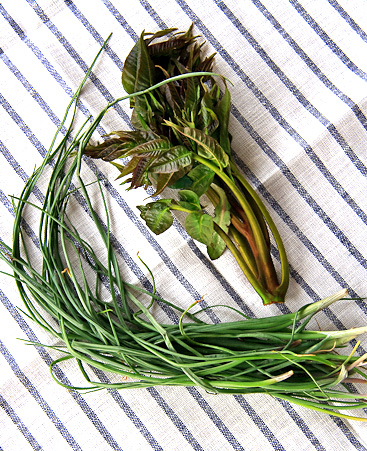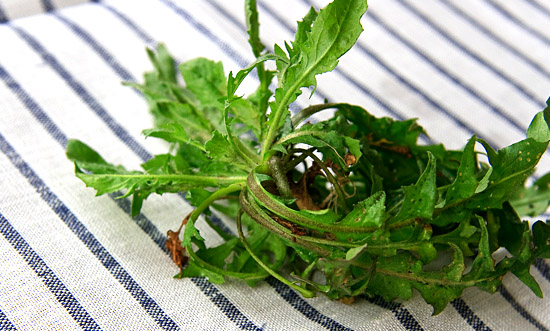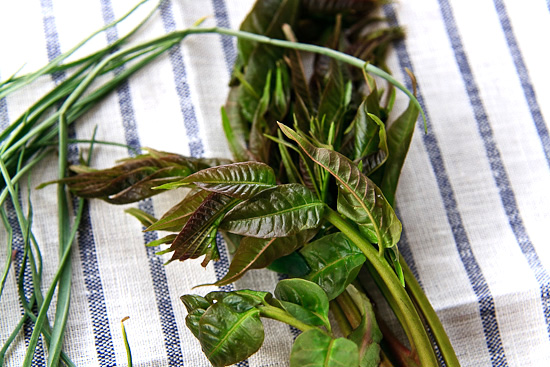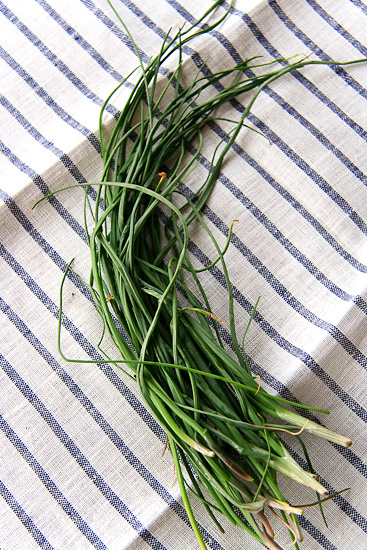It’s a rare chance that we get to appreciate the weird and wondrous ways of nature in the midst of Beijing, but our weekly vegetable deliveries from Therese’s organic farm usually do the trick.
Though Therese’s vegetables are usually quite conventional, every spring she offers ‘wild vegetables’ (野菜 yecai) from her farm, God’s Grace Garden. Last year we ate our way through large bags of thistles and other tough, prickly plants – in all honesty, they should really be called weeds. This year, there was a fresh new round of wild vegetables. Forgetting my thistle lesson from yesteryear, I ordered them all.

Therese brought bags of prickly, oddly shaped plants, the dirt still clinging to their roots and their leaves blemished. There were surprisingly familiar ones too: one of them was none other than the humble dandelion.
Left in a bowl of water to soak overnight, the dandelions recovered enough to poke their heads up: an unruly, tangled bouquet. In what seemed like no time, its yellow flowers dissolved into dandelion fluff. Such a wonder had surely never happened in our kitchen?
Later there were many meals of dandelion salad and dandelion hummus, as well as pies (xianbing), eggs and other salads all made with our strange new weedy friends.
Perhaps nothing was pricklier than shepherd’s purse (荠菜 jicai). Despite its rough, jaggedy appearance, shepherd’s purse is often eaten around the Shanghai region. It can be stir-fried with sticky rice cakes (荠菜炒年糕 jicai chao niangao), stirred into rice porridge (荠菜粥 jicai zhou), made into soup or, most popularly, combined with ground pork as a filling for wontons (馄饨 huntun), dumplings, buns and pies.
I opted for the latter, using a vegetarian filling with scrambled eggs instead of pork. Seasoned lightly with sesame oil and salt, the mixture of shepherd’s purse and egg went inside a simple bing dough (about 60% water to flour) to become stuffed pies (馅饼 xianbing), gently pan-fried.
We also received the leaves of the Chinese toon (香椿 xiangchun), a tall, deciduous tree also called the Chinese mahogany. Its leaves have a strong, herbal odor that many people dislike (but to their loss: Wikipedia suggests that Chinese toon can kill cancer cells and increase the ‘dynamic activity’ of sperm).
A popular way to eat toon is 香椿拌豆腐 (xiangchun ban doufui), a cold salad of soft, creamy tofu and toon leaves (blanch them quickly first) with a little sesame oil and salt. We like to scramble toon with egg and chili peppers, and sometimes a little scallion. They would also be great folded into an omelet – the egg helps to take the edge off the leaves’ faint medicinal aroma.
The most exotic ‘vegetable’ we received was the lycoris or red spider lily (石蒜 shisuan) – just one look at its flowers would tell you why. Though the plant is known rather prosaically as “stone garlic”, its story is far more legendary: lycoris is the flower of the Buddhist heaven, and the flower of the underworld. In Sanskrit, it’s called Manjusaka (曼珠沙华), the celestial flower.
In Chinese, they are the “flower of the other shore” (彼岸花 bi’an hua). Their blood-red flowers bloom in a swathe along the path from the river of forgetfulness to the underworld, guiding souls to their final home. Because of their bright red hues, the road to hell can be called “the path lit by fire” (火照之路 huozhao zhi lu).
One other strange thing about this plant is that its flowers and leaves never meet: when the leaves grow, the flowers have withered, and in autumn, when the flowers bloom, the leaves have died. As such, they symbolize farewells and separated lovers.
I wish I could tell you that this plant tasted as otherworldly as its legendary billing. We blanched it in hot water before dressing it with chili peppers, vinegar and oil; the plant itself had a mild, sweet, scallion-like flavor. But it neither whisked us off to the underworld, nor brought us a little closer to heaven. Dare I say false advertising?

































Paved with good intentions, and now following a river lined with amazing flowers …
The road to hell sounds nicer than ever.
The thistle bag link appears to be pointing to your sourdough page, is that intended?
Ah, that’s a mistake! Thanks for spotting it.
Thanks for ID-ing all the these plants – I’ve seen some around, and never knew what some were or how to use them! I love that you have dandelions blooming and fluffing in your kitchen.
Big fans of 香椿 in Shanghai. When we went to Liu Jian’s hometown we saw it growing in his grandparent’s backyard, so we took a sprig and brought it back to Shanghai. Now we’re growing our own little xiangchun tree. It will be a while before we have enough to make dinner with though.
[...] di casa, che ne è ghiotto, abbiamo deciso di ordinare una porzione grande di 荠菜馄饨 – jìcài húntun – wonton con verdure tipiche della 沪菜 – hùcài – la cucina di [...]